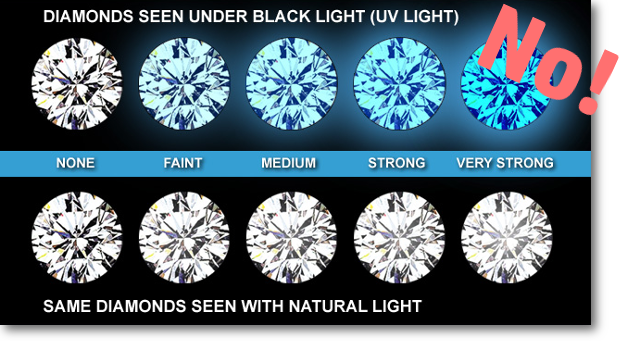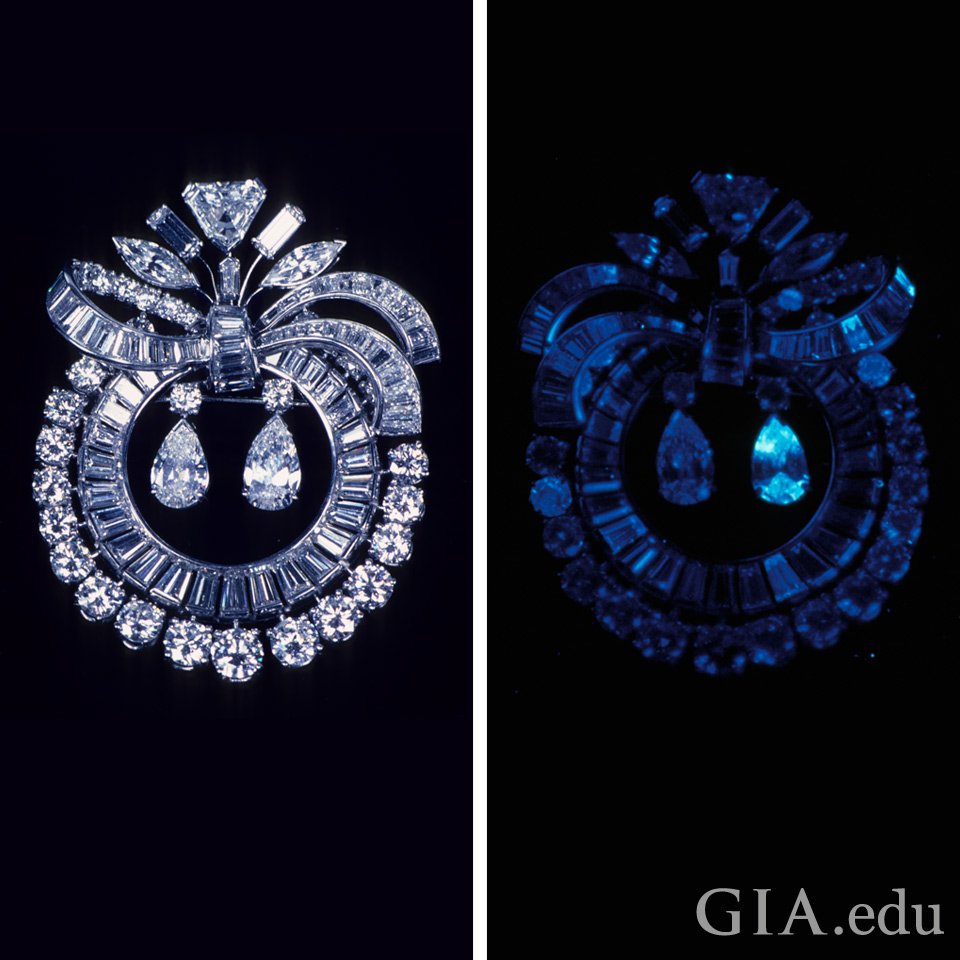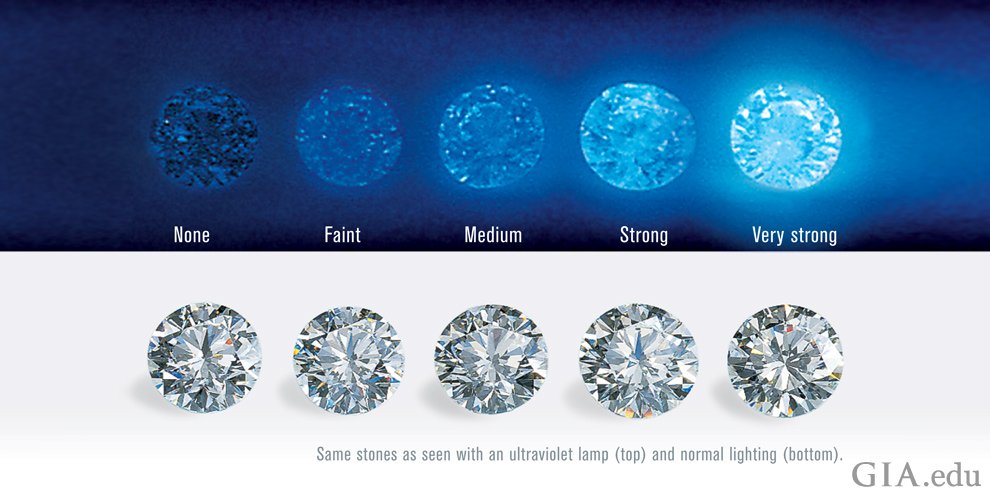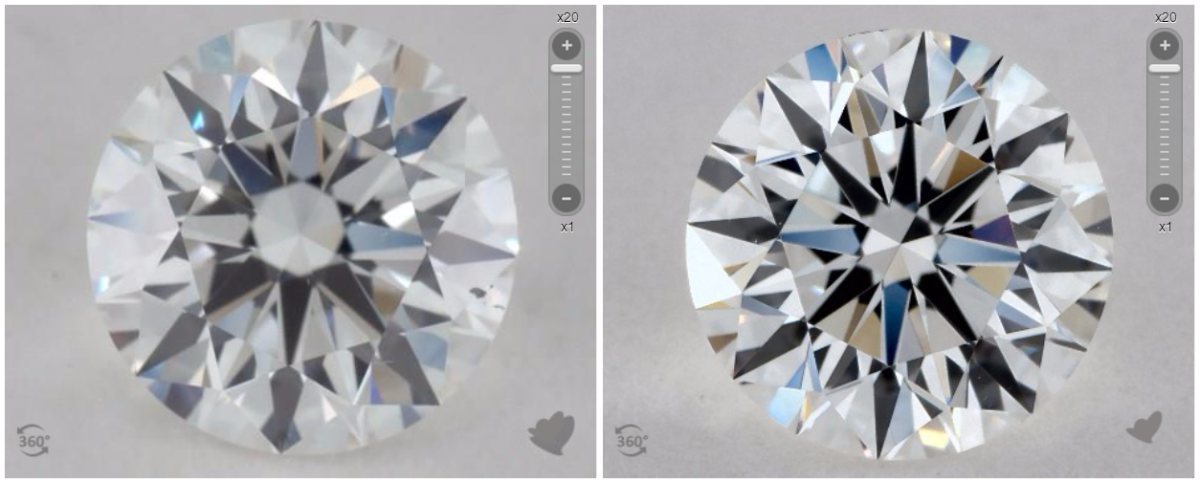
Welcome… to a rather misunderstood topic.
If you want your engagement ring to look amazing, it’s important to ensure the main diamond is the star of the show and has all the brilliance and fire you would expect from a diamond.
Fluorescence is a little-known diamond specification that can drastically alter the price and appearance of any diamond you cross paths with.
Mother nature rolled the dice and around 30% of diamonds emit some degree of a fluorescent glow when exposed to concentrated UV light. It’s random, as you can see in the image above.
As you know there’s UV in sunlight, and although far from concentrated there is a small reaction a diamond has with the UV light in natural sunlight.
In natural everyday light, even the most experienced diamond graders find it impossible to tell what the fluorescent grade of a diamond is.
Stick with me.
1. How do you determine if a diamond has fluorescence?
Most grading laboratories state the intensity and colour of the fluorescence on the grading report or inside the diamond parcel on a sticker-note.
Any decent jeweller will have a UV flashlight that will reveal the colour and intensity of fluorescence when pointed directly at a diamond. It’s interesting to see. Blue fluorescence is by far the most common, and what you should be looking for.
For more information on diamond grading laboratories this blog (link) will be a good starting point.
2. So, how do I know if the fluorescence grade is affecting a diamond’s appearance?
It’s important to know that diamond fluorescence comes in every colour of the rainbow. The only one that will has an upside is blue. Steering clear from other colours of fluorescence is a great starting point.

*These diamonds are all fluorescing under strong UV light. In normal light, they’re all shades of white with no faint hue of colour from the fluorescence.
Secondly, the intensity of the fluorescence will determine the magnitude of the effect, if any.
The impact of “none”, “faint” and “medium” fluorescent grades can be ignored.
*This image supplied by the GIA, clearly shows how a diamond can have a high fluorescent grade, but still look perfectly fine in normal light.
When a diamond is negatively influenced you can often spot some cloudiness in the diamond – that’s most probably fluorescence gone rogue.
At the polar opposite, if a diamond has been positively influenced by this fluorescence reaction, the colour just appears to be whiter. There’s not a hint that fluorescence upped the colour you see by a grade or two. Even to very experienced eyes the colour grade simply appears to be higher than that stated on the grading certificate.
Images like the one below make it out to be an obvious, predictable effect that a diamond looks more dull and milky as fluorescence increases. That’s an oversimplification to the point where it’s noise. It’s just factually deficient.

3. When and how does a diamond benefit from a strong fluorescent grade?
Diamond colours range from D (the ice white cream of the crop) down the alphabet to Z.
Z-colour has a prominent yellow or brown hue.
The possible effect of fluorescence differs from one colour range to the next.
J K L M colour diamonds: Improved colour.
As you saw in the image fluorescence is mostly blue, but it also turns the diamond into a small but expensive glowing bulb of sorts.
Although the effect is much less pronounced in normal lighting conditions, that reaction happens on a mini level and increases the perceived colour by a grade or so in certain colour categories (J-M).
Because these diamonds appear whiter than they are in sterile laboratory light, they sell at a small premium. That 2%-5% premium is well spent to up the colour into the whiter territory.
A K-colour diamond with strong blue fluorescence can easily look like it’s somewhere between an I and a J.
Using fluorescence in your favour is a much more affordable way to up the colour a notch. It’s actually a little-known diamond buying hack.
Just keep in mind… this colour elevation effect rarely occurs on colours higher than I.
Although the improvement in perceived colour is rather predictable, these diamonds can still, although rarely, have some cloudiness in them.
This is one of those nuances that calls for dealing with a jeweller who has very experienced eyes, and can guide you along. Ensure the diamond you choose is crystal clear.
Milkiness appears in grades, sometimes it’s not obvious… until you know what to look out for. You don’t have to ram into an iceberg to learn this lesson.
We curate our diamond stock obsessively to ensure every diamond we sell is free from any detrimental effect of fluorescence.
D E F colour diamonds: Great Deals… Maybe.
These high-end colours are most vulnerable to the negative effects of fluorescence.
Keep in mind, many are entirely unaffected by any grade of fluorescence and will appear identical to other options in this range that are free from even a hint of fluorescence.
In bad cases, the fluorescence in D-E-F coloured diamonds can make them look very cloudy and milky. This compromised lustre can be from barely visible to all fogged up inside.
*These diamonds are the same size and colour. But it’s obvious that fluorescence has compromised the diamond on the left.
Many buyers in the highest tier would rather pay a premium than figure out this fluorescence topic. So, the demand for diamonds in these top colours without fluorescence is higher than for those with it. This demand deviance creates substantial pricing differences.

*A very high end neck-piece where it’s clear the diamonds that emit fluorescence have no detrimental effects to their appearance.
I can easily find you a D-E-F colour diamond with strong fluorescence that’s completely free from any hazy compromises at up to a 30% discount to those without fluorescence.
Every diamond we stock has been evaluated by an gemologist who amongst other things comments on the visual impact of its fluorescence. We only deal in diamonds that aren’t negatively effected by their fluorescent grades.
You can view all our diamonds HERE, and please get in touch for any special requests or if you have questions.
Where to from here?
Please make us your first stop. We’ve got your back.
It’s never too early to reach out, and you’ll save yourself a lot of time.
You’re welcome to read the over 200 000 words on this blog, but my whole crew is marinated with diamond knowledge.
Our studios in Pretoria & Rosebank have brilliant full time designers, and you’re welcome to visit us for a session with one of them – no strings attached and zero sales pressure.
If distance is an issue – emails & phone call work better than you would imagine.
For questions, quotes and consultation bookings please feel free to reach out on info@poggenpoel.com or get in touch via your preferred channel.
Take care.
Johan Poggenpoel
Co-Founder.




